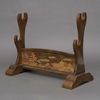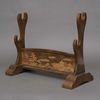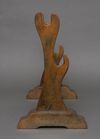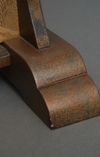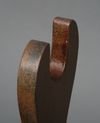A JAPANESE WOODEN SWORD STAND, TAISHÕ PERIOD (1912-1926)
Nashiji lacquer 梨子地 wooden sword stand 刀掛け (katana’kake) for two swords, more specifically for a daishô 大小-set, decorated with golden hiramaki-e 平蒔絵 (low-relief design). The lovely maki-e on the front depicts a broad view of a mountain scape; traditional Japanese houses on the right next to a river, on the left some stylized pine trees on a hill.The design is executed in different hues of gold on a nashiji background. This colour combination gives the sword stand a calm and serene appearance. The katana’kake is in a very good condition with only some very minor traces of age and wear. Please look at the photos for a condition reference.
Height 38.6 cm, Width 49.8 cm, Depth 23.3 cm. Taishō period (1912-1926). A daishô sets consists of a katana and tanto. It refers to the act of carrying two swords: a large and small sword. Samurai warriors in feudal Japan discovered that carrying a large sword and a small sword gave them a competitive advantage over their enemies on the battlefield.

